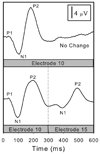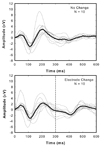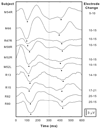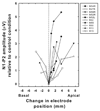The electrically evoked auditory change complex: preliminary results from nucleus cochlear implant users
- PMID: 18596644
- PMCID: PMC2767236
- DOI: 10.1097/AUD.0b013e31817a98af
The electrically evoked auditory change complex: preliminary results from nucleus cochlear implant users
Abstract
Objectives: The purpose of this study was to determine if changes in the position of the stimulating electrode in the cochlea could be used to elicit the electrically evoked auditory change complex (EACC) from Nucleus cochlear implant users.
Design: Nine postlingually deafened adults participated in this study. Each study participant had been using his or her Nucleus CI24 cochlear implant for at least 3 mos before testing. The speech processor was bypassed and the output of the implanted receiver/stimulator was controlled directly. The stimulus was a 600 msec burst of a biphasic pulse train (1000 pps). In control conditions, the stimulating electrode was held constant and stimulation continued throughout the 600 msec recording interval. In experimental conditions, the EACC was elicited by introducing a change in the stimulating electrode 300 msec after the onset of the pulse train. The EACC was recorded using surface electrodes. Three recordings of 100 sweeps each were obtained for each stimulus condition. Bandpass filtering (1-100 Hz) was used to minimize contamination of the recordings by stimulus artifact. Averaged responses were then smoothed using a 40-msec wide boxcar filter and standard peak picking procedures were used to analyze these responses in the time domain.
Results: In each case, a clear onset response (P1-N1-P2) was recorded. In the experimental conditions, a second evoked potential, the EACC, was also recorded after the change in stimulating electrode. This second response had general morphological characteristics that were very similar to those of the onset response. Increasing the separation between the two stimulating electrodes in the experimental conditions resulted in a general trend toward increased EACC amplitudes.
Conclusions: This report describes results of a set of experiments in which the speech processor of the cochlear implant was bypassed and the EACC was recorded in response to a change in stimulating electrode position. EACC amplitude was shown to increase as the separation between the two stimulating electrodes increased. Although preliminary in nature, these results demonstrate the feasibility of recording the EACC in response to changes in stimulating electrode position from individual cochlear implant users.
Figures





Similar articles
-
The effect of changes in stimulus level on electrically evoked cortical auditory potentials.Ear Hear. 2009 Jun;30(3):320-9. doi: 10.1097/AUD.0b013e31819c42b7. Ear Hear. 2009. PMID: 19322089 Free PMC article.
-
Objective measures of electrode discrimination with electrically evoked auditory change complex and speech-perception abilities in children with auditory neuropathy spectrum disorder.Ear Hear. 2014 May-Jun;35(3):e63-74. doi: 10.1097/01.aud.0000436605.92129.1b. Ear Hear. 2014. PMID: 24231629 Free PMC article.
-
Gap detection measured with electrically evoked auditory event-related potentials and speech-perception abilities in children with auditory neuropathy spectrum disorder.Ear Hear. 2013 Nov-Dec;34(6):733-44. doi: 10.1097/AUD.0b013e3182944bb5. Ear Hear. 2013. PMID: 23722354 Free PMC article.
-
The Electrically Evoked Auditory Change Complex Evoked by Temporal Gaps Using Cochlear Implants or Auditory Brainstem Implants in Children With Cochlear Nerve Deficiency.Ear Hear. 2018 May/Jun;39(3):482-494. doi: 10.1097/AUD.0000000000000498. Ear Hear. 2018. PMID: 28968281 Free PMC article.
-
Neurophysiology of cochlear implant users I: effects of stimulus current level and electrode site on the electrical ABR, MLR, and N1-P2 response.Ear Hear. 2002 Dec;23(6):502-15. doi: 10.1097/00003446-200212000-00002. Ear Hear. 2002. PMID: 12476088
Cited by
-
Relationships Among Peripheral and Central Electrophysiological Measures of Spatial and Spectral Selectivity and Speech Perception in Cochlear Implant Users.Ear Hear. 2015 Jul-Aug;36(4):441-53. doi: 10.1097/AUD.0000000000000144. Ear Hear. 2015. PMID: 25658746 Free PMC article.
-
Objective assessment of spectral ripple discrimination in cochlear implant listeners using cortical evoked responses to an oddball paradigm.PLoS One. 2014 Mar 5;9(3):e90044. doi: 10.1371/journal.pone.0090044. eCollection 2014. PLoS One. 2014. PMID: 24599314 Free PMC article.
-
Acoustic Change Complex: Clinical Implications.J Audiol Otol. 2015 Dec;19(3):120-4. doi: 10.7874/jao.2015.19.3.120. Epub 2015 Dec 18. J Audiol Otol. 2015. PMID: 26771009 Free PMC article. Review.
-
The effect of changes in stimulus level on electrically evoked cortical auditory potentials.Ear Hear. 2009 Jun;30(3):320-9. doi: 10.1097/AUD.0b013e31819c42b7. Ear Hear. 2009. PMID: 19322089 Free PMC article.
-
Musicians Are Better than Non-musicians in Frequency Change Detection: Behavioral and Electrophysiological Evidence.Front Neurosci. 2016 Oct 25;10:464. doi: 10.3389/fnins.2016.00464. eCollection 2016. Front Neurosci. 2016. PMID: 27826221 Free PMC article.
References
-
- Abbas PJ, Hughes ML, Brown CJ, et al. Channel interaction in cochlear implant users evaluated using electrically evoked compound action potentials. Audiology & Neurotology. 2004;9:203–213. - PubMed
-
- Agung K, Purdy SC, McMahon CM, et al. The use of cortical auditory evoked potentials to evaluate neural encoding of speech sounds in adults. Journal of the American Academy of Audiology. 2006;17:559–572. - PubMed
-
- Beynon AJ, Snick A, van den Brock P. Evaluation of cochlear implant benefit with auditory cortical evoked potentials. International Journal of Audiology. 2002;41:429–435. - PubMed
-
- Delb W, Strauss DJ, Hohenberg G, et al. The binaural interaction component (BIC) in children with central auditory processing disorders (CAPD) International Journal of Audiology. 2003;42:401–412. - PubMed
-
- Eggermont JJ, Ponton CW. Auditory-evoked potential studies of cortical maturation in normal hearing and implanted children: correlations with change in structure and speech perception. Acta Oto-Laryngologica. 2003;123:249–252. - PubMed
RELATED PUBLICATION
-
- Friesen LM, Tremblay KL. Acoustic change complexes recorded in adult cochlear implant listeners. Ear and Hearing. 2006;27:678–685. - PubMed
-
- Gilley PM, Sharma A, Dorman M, Finley C, Panch A, Martin K. Minimization of cochlear implant stimulus artifact in cortical auditory evoked potentials. Clinical Neurophysiology. 2006;117:1772–1782. - PubMed
-
- Martin BA. Can the acoustic change complex be recorded in an individual with a cochlear implant? Separating neural responses from cochlear implant artifact. Journal of the American Academy of Audiology. 2007;18:126–140. - PubMed
-
- Martin BA, Boothroyd A. Cortical auditory event-related potentials in response to periodic and aperiodic stimuli with the same spectral envelope. Ear and Hearing. 1999;20:33–44. - PubMed
-
- Martin BA, Boothroyd A. Cortical, auditory evoked potentials in response to changes of spectrum and amplitude. Journal of the Acoustical Society of America. 2000;107:2155–2161. - PubMed
Publication types
MeSH terms
Grants and funding
LinkOut - more resources
Full Text Sources
Medical

